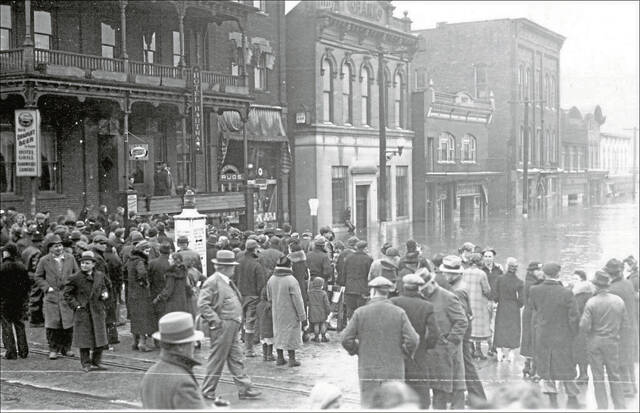Apollo Area Historical Society revisits the St. Patrick Day’s flood of 1936
For the first time in six years, the Apollo Area Historical Society is offering its walking tour of the 1936 St. Patrick’s Day flood. This year’s tour will be March 19, a Saturday.
The hourlong walking tour will feature borough sites that were hard hit, some of them marked with blue painter’s tape to illustrate the waterline from the infamous flood.
The society also will offer an indoor presentation on the flood at the society’s museum in Apollo. Both events are free, but donations are welcome.
In the Pittsburgh region alone, the flood’s devastation caused 62 deaths and 500 injuries and left 135,000 people homeless, according to the Sen. John Heinz History Center. Caused by a heavy rainfall matched with a warm snap that melted the season’s snow, the flood added urgency to the construction of dams and reservoirs that regulate waterways today.
The Kiski River at Vandergrift rose to a depth of nearly 42 feet — more than 15 feet above flood stage, according to historical records.
Remarkably, there were no deaths in the Apollo area.
But the borough lost its bridge across the Kiski River, and 95 area homes were damaged or washed away, according to the historical society.
An army of people have claimed to be the last to cross the Apollo Bridge before floodwaters swept the structure off its pillars, said Sue Ott, society vice president.
When the borough lost its bridge, a new one wasn’t completed until two years later, she noted.
“It really hurt the businesses in Apollo and it played a big part in the town’s economic conditions for years,” she said.
In an account in the Apollo Sentinel newspaper, resident Margaret Rau retold a story from her father witnessing a man trying to lasso furniture floating by the porch of the Elks Club along Warren Avenue.
The current was too strong for another resident, who roped a refrigerator but couldn’t pull it in.
Rau was among a group of people gathered in the backyards of houses on Sherman Avenue in Vandergrift close to the Vandergrift Bridge.
“Houses came floating down as many as five in a row. Some hit the bridge and splintered like matchboxes. Dust and fragments flew through the air,” she wrote.
Although no one died in the flood, there were many saved, according to Rau’s account. She recognized the many firefighters who navigated through town in rowboats rescuing residents from their homes.
One resident in North Vandergrift, whose wife was disabled, didn’t want to leave his house, according to Rau.
“It was not until the second trip by boat that those heroic East Vandergrift men rescued them from a second-story window,” Rau wrote. “The house later washed away.”
The walking tour gives the public the sensation of what it would have been like for the water to be so high people could have been swimming through the streets, Ott said.
The walking tour is relatively easy as it covers the borough’s flats below Pennsylvania Avenue for about 10 blocks.
Remove the ads from your TribLIVE reading experience but still support the journalists who create the content with TribLIVE Ad-Free.

